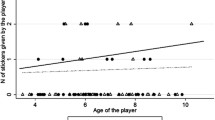Abstract
Forty black first- and second-grade children were given instructions intended to induce possessiveness for both a designated toy and a play area, along with an opportunity to play with the toy in the area. Each subject then surreptitiously observed an experimental confederate dressed in a clown costume play with either the designated toy or another toy, while either within or outside the child's play area. While observing the invasion, the child had 10 opportunities (trials) to deliver shock to the confederate. Girls who observed the confederate playing with the designated toy delivered more shocks and waited fewer trials to deliver the first shock than did the other girls. Similar effects were produced by the confederate's use of the subject's play area. The manipulations produced no significant effects upon the boys' aggression.
Similar content being viewed by others
References
Altman, I. Territorial behavior in humans: An analysis of the concept. In T. Pastalan (Ed.),The use of space in elderly populations. Ann Arbor: The University of Michigan, 1970.
Altman, I.The environment and social behavior. New York: Brooks-Cole, 1975.
Altman, I., Taylor, D., & Wheeler, L. Ecological aspects of group behavior in social isolation.Journal of Applied Social Psychology, 1971,1, 76–100.
Ardrey, R.The territorial imperative. New York: Delta, 1966.
Bandura, A.Aggression: A social learning analysis. Englewood Cliffs, N.J.: Prentice-Hall, 1973.
Baughman, E.The black society. New York: Atherton, 1971.
Becker, F., & Mayo, C. Delineating personal distance and territoriality.Environment and Behavior, 1971,3, 375–381.
Boice, R. In the shadow of Darwin. In R. Green & E. O'Neal (Eds.),Perspectives on aggression. New York: Academic Press, 1976.
Edney, J. Human territoriality.Psychological Bulletin, 1974,81, 959–975.
Edney, J. Territoriality and control: A field experiment.Journal of Personality and Social Psychology, 1975,31, 1108–1115.
Edney, J. Human territories: Comment on functional properties.Environment and Behavior, 1976,8, 31–48.
Eibl-Eibesfeldt, I.Ethology: The biology of behavior. New York: Holt, Rinehart and Winston, 1970.
Hanratty, M., O'Neal, E., & Sulzer, J. Effect of frustration upon imitation of aggression.Journal of Personality and Social Psychology, 1972,21, 30–34.
Hediger, H.Wild animals in captivity. London: Butterworth, 1950.
Jones, S., & Aiello, J. Pr oxemic behavior of black and white first-, third-, and fifth-grade children.Journal of Personality and Social Psychology, 1973,25, 21–27.
Krail, K., & Leventhal, G. The sex variable in the intrusion of personal space.Sociometry, 1976,39, 170–173.
Liebert, R., & Baron, R. A. Short-term effect of televised aggression on children's aggressive behavior. In J. Murray, E. Rubinstein, & G. Comstock (Eds.),Television and social behavior. Washington, D.C.: U.S. Government Printing Office, 1972, 181–201.
Lyman, S., & Scott, M. Territoriality: A neglected social dimension.Social Problems, 1967,15, 236–249.
Mallick, S., & McCandless, B. A study of catharsis of aggression. In L. Berkowitz (Ed.),Roots of aggression. New York: Atherton, 1969.
Newman, O.Defensible space. New York: Macmillan, 1973.
Proshansky, H., Ittelson, W., & Rivlin, L.Environmental psychology. New York: Holt, Rinehart and Winston, 1970.
Russo, N. Eye contact, interpersonal distance, and the equilibrium theory.Journal of Personality and Social Psychology, 1975,31, 497–502.
Scott, J. Agonistic behavior of mice and rats: A review.American Zoologist, 1966,6, 683–701.
Shaffer, D., & Sadowski, C. This table is mine: Respect for marked barroom tables as a function of gender, spacial marker, and desirability of locale.Sociometry, 1975,38, 408–419.
Sommer, R., & Becker, F. Territorial defense and the good neighbor.Journal of Personality and Social Psychology, 1969,11, 85–90.
Storr, A.Human aggression. New York: Atheneum, 1968.
Wolf, L. Female territoriality in the purple-throated carib.Auk, 1975,92, 511–522.
Author information
Authors and Affiliations
Rights and permissions
About this article
Cite this article
O'Neal, E., Caldwell, C. & Gallup, G.G. Territorial invasion and aggression in young children. J Nonverbal Behav 2, 14–25 (1977). https://doi.org/10.1007/BF01127014
Issue Date:
DOI: https://doi.org/10.1007/BF01127014




